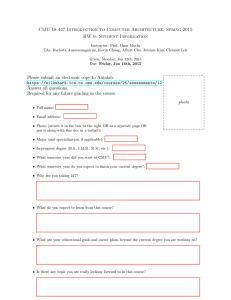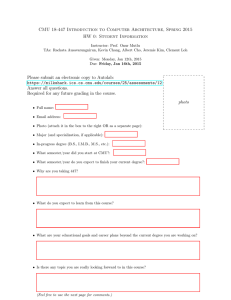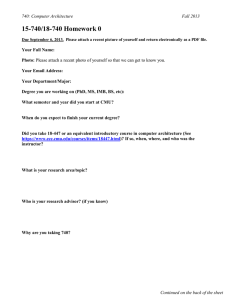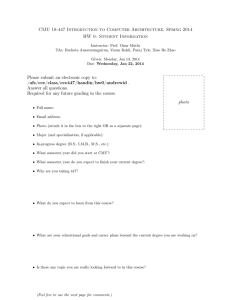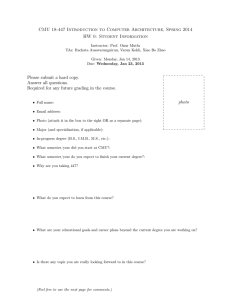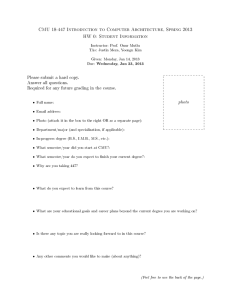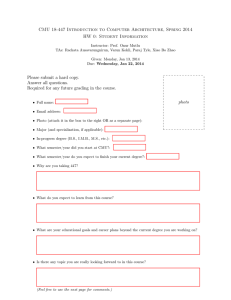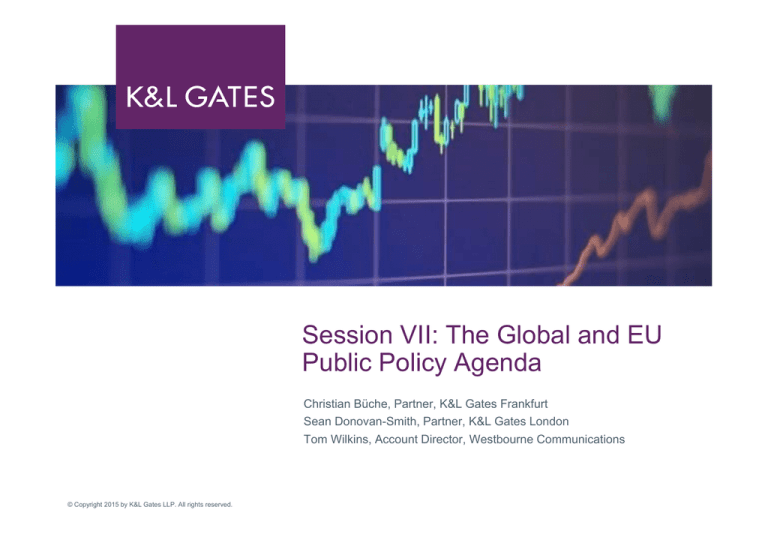
Session VII: The Global and EU
Public Policy Agenda
Christian Büche, Partner, K&L Gates Frankfurt
Sean Donovan-Smith, Partner, K&L Gates London
Tom Wilkins, Account Director, Westbourne Communications
© Copyright 2015 by K&L Gates LLP. All rights reserved.
Presentation outline
The recent UK election and its possible
consequences
The European Commission’s proposal for a
Capital Market Union
Mutual recognition and equivalence across
jurisdictions, including third-country access to the
EU
The outlook for development of MIFID and EMIR
projects
Reform of Money Market Funds’ regulation
204
Impact of BREXIT on Financial Services
British business will voice even more loudly its opposition
to the UK leaving the EU
Big banks and funds’ possible relocation outside the UK
or outside the EU
British Chamber of Commerce letter to the PM
‘take action to secure the UK’s economic future’ (11 May 2015)
Bertelsmann Stiftung and Ifo institute, Germany
Brexit could cost the UK up to 14 percent of GDP
Threat to the Capital Markets Union (CMU)
klgates.com
205*
Consequences for the financial sector
Moody’s : ‘ditching the EU could be harmful to the UK and there is
very little to gain by leaving the EU’
Loss of appeal for investors — FTSE 100 is a major hub for
international companies to list
Financial sector against a Brexit: possible banks’ relocation outside
the UK i.e. Goldman Sachs
A danger to the Capital Markets Union (CMU)
EU level — support for Commissioner Hill proposed CMU may weaken
CMU is organised around all 28 member states, losing the UK and its key
financial centres will make a CMU less appealing
Frankfurt stronger financial hub? Increasing ECB importance…
206
Alternatives to the EU
Swiss approach
The UK receives a status similar to Switzerland — trade agreement with the
EU, but not all important issues covered: Switzerland has a free trade in
goods but not on services (unlike the EEA)
Series of bilateral negotiations and agreements
UK’s financial services industry would face the challenges: Switzerland only
has an agreement on non-life insurance and nothing on else on the financial
services side.
European Economic Area (EEA)
Allows UK access to EU’s single market
UK can adopt almost all the relevant EU legislation, but loss of influence on a
number of important issues such as trade (no formal vote)
Free trade agreement (FTA)
Need to ensure that any FTA signed includes access to EU services markets
UK will not be in a position to push for further liberalisation
207
What now ?
George Osborne and Philip Hammond will have relevant
roles in negotiations
Cameron embarks on EU tour
1 June – talks with Germany, France and Commission President
Juncker
9 June 2015 – UK Parliament passed EU referendum bill
10/11 June 2015 – EU Summit (Brussels)
One on one talks with Spain, Finland, Romania and Cyprus
June 2015 – European Council Summit
2017 – In/out referendum
In the event of a Brexit, likely to take 10-15 years to
unwind Britain’s EU commitments
208
Broad areas for renegotiation
Internal market
Jobs and growth
Eurozone integration
Protection of member states/economies not in Eurozone
Two-speed Europe
Subsidiarity principle
More say for national parliaments on regulation
Social benefits
Protection against ‘benefits tourism’
Further development of other freedoms (services and
capital)
209
Capital Market Union
CMU in context
Jean-Claude Juncker (then candidate for Commission President):
‘to improve the financing of our economy, we should further develop and integrate
capital markets. This would cut the cost of raising capital, notably for SMEs, and help
reduce our very high dependence on bank funding. This would also increase the
attractiveness of Europe as a place to invest’ (European Parliament Plenary, 15 July
2014)
Appointment of Lord Hill – Commissioner for Financial Stability, Financial Services and
Capital Markets Union
18 February 2015: Commission publishes Green Paper ‘Building a Capital Markets’
Union’ Capital markets in EU are:
Fragmented
Underdeveloped and
Play less of a significant role in financing the economy compared to other jurisdictions
Green Paper outlines:
Challenges facing EU capital markets
Priorities for early action
Measures to develop and integrate capital markets and
Next steps
211
Components of a CMU
CMU
PROSPECTUS
DIRECTIVE
Two specific
consultations were
launched in parallel to
the CMU Green Paper
SECURITISATION
212
Prospectus Directive
Cornerstone of EU capital markets regulation
Last amended in 2010 and due for review in January 2016
Recent Consultation Paper seeks to:
Examine ways to simplify the information included in prospectuses
Examine when a prospectus is necessary and when it is not and
How to streamline the approval process
Why the need for review? Reduction of burdens on issuers = easier
and more affordable to raise funds
Disadvantages of current rules:
Costly
Complex
Too much information disclosure required
213
Securitisation
Recent Green Paper prioritises the development of a sustainable high
quality securitisation market
Consultation Paper: ‘An EU Framework for simple, transparent and
standardised securitisation’
Objectives:
Lord Hill – ‘encourage safe, high-quality securitisation’
US markets have recovered to pre-crisis levels in contrast to EU
European Securitisation market issuance volume down from €367
billion (2009) - €156 billion (2014)
Decline in professionals and active market participants
Progress made by EBA, BoE and ECB
214
Why is a CMU necessary?
Lord Hill:
‘…..the purpose of a Capital Markets Union is to make it easier to link
savings to growth and to channel savings from anywhere in the EU to
be invested in businesses anywhere in the EU. The goal is a true
Single Market in capital.’
Improvement of SME access to funding
Establish a genuine single capital market
Phil Evans, director (International), Bank of England states three
benefits:
Better match of borrowers and investors (allocative efficiency);
Combating the overreliance on bank funding; and
Enhancing risk-sharing across the EU
215
Overall objectives of the CMU
Put in place the building blocks of an integrated and wellfunctioning single market for capital by 2019
The CMU is a project for all 28 member states, not for a
subset
It is built on the foundations of financial stability created
by the Banking Union and other financial reforms over the
the last five years
The Single Rulebook needs to be effectively and
consistently enforced
216
How to improve access to finance
Address information problems
Encourage banks to provide feedback to SMEs whose
credit has been declined
Development of more tailored accounting rules for
SMEs
Creation of a European Investment Project Pipeline
Dedicated website to ease access to information for investors
on infrastructure projects
217
Challenges to a CMU
Cultural and legal traditions constraints in Member States
EU markets’ lack of harmonisation
Supervision – especially in technical areas
Distinction to be drawn between common rulebook vs single
supervisor
Issue of centralised supervision: ESMA and ECB
International consistency
Capital markets’ financing to complement, not replace
banking sector
218
Opportunities created by CMU
UK
CMU cannot be properly achieved without London/UK
Half of all capital markets activity derive through the UK
Increase in capital markets would reap great fruits to the UK
economy and the City of London
UK should ensure its place at the forefront of the discourse
SMEs
Improved access to finance for SMEs
SMEs are critical to the EU economy (jobs and growth)
Focus on medium-sized companies
Focus on ambitious SMEs
219
CMU Consultation
Seven hundred responses received to CMU consultation and over
120 responses to its securitisation consultation.
The Commission currently analysing response
Response will form Action Plan to be presented in September
Key initial takeaways
Step missing in the ‘funding escalator’ in Europe
Need to eliminate barriers for capital to move across the EU
Need to strengthen venture capital ecosystem in Europe
Need to look at best practices from some EU countries on private
placement
Ambiguity in regulatory treatment of private placements
Divergences and inconsistencies
220
Timeline
18 February – adoption of the CMU Green Paper
13 May – deadline for responses to consultation(s)
8 June – Public hearing, Brussels
16 June – ECON vote on its motion for a resolution on
CMU
19 June – ECOFIN Council meeting
Action plan on CMU to be published after summer and
followed by specific legislative proposals
CMU expected to be set up progressively in the
coming years
221
Mutual Recognition and Equivalence across
Jurisdictions, Including Third-Country
Access to the EU
Framework established for financial institutions, funds and market
infrastructure established outside the EU to access European
investors and markets
Cooperation agreements to be put in place between third country and
EU member state or ESMA
Access to EU financial markets based on national laws and are
divergent
223
Recognition of third-country regulatory regime
Equivalence determination
Co-operation agreements
Tax agreements
224
MIFID II
AIFMD
Requirements
Non-EU country not listed as a
NCCT by FATF;
A co-operation agreement in place;
Tax agreements in place; and
Services will be subject to ongoing
supervision by third-country regulator
Requirements
A co-operation agreement
Non-EU country not listed by the
FATF as a NCCT; and
Tax-exchange agreement
Consequences
Third-country investment firms
unable to provide investment
services to any clients
Consequences
Non-EU AIFMs can’t market AIFs
(EU or non-EU AIFs) in the EU, or
manage EU AIFs
EU AIFMs can’t market non-EU AIFs
in EU
225
EMIR (clearing houses)
EMIR (clearing, derivatives)
Requirements
Co-operation agreement
Determination of equivalence
Requirements
Determination of equivalence
No co-operation agreement required, but nonEU country needs to assist ESMA in
preparing its technical advice on equivalence
Two non-EU entities trading with each other,
Commission to impose EMIR’s obligations on
each if contract falls within EMIR’s
extraterritoriality provisions which apply:
Consequences
Inability of non-EU clearing
houses to clear for EU clearing
members and EU exchanges
and trading venues
(a) if the contract has a “direct or foreseeable
effect” in the EU; or
(b) if it is necessary to prevent the evasion of
EMIR
Consequences
EU financial counterparties may be unwilling
to trade with non-EU counterparties whose
third countries have not been found equivalent
226
Solvency II
Benchmarks regulation
Requirements
Determination of equivalence
Requirements
Co-operation agreement
Determination of equivalence
Administrator is registered by ESMA
Compliant with IOSCO Principles for
Financial Benchmarks
Solvency II to come into effect 1
January 2016
Consequences
Reinsurance contracts with non-EEA
insurers to be treated differently to
EEA-insurers
Third-country insurers not part of
EEA-groups
Consequences
Benchmark administrators will not be
able to provide benchmarks to EUsupervised entities for use within the
EU.
group will not be able to take into
account the local third-country
calculation of capital
227
Money Market Funds (MMFs)
MMFs in brief…
Important source of short-term financing
Includes treasury bills, corporates and
governments
Hold almost 40% short-term debt issued by
banking sector
Financial crisis highlighted MMFs can be
susceptible to systematic risk due to:
Size and interconnectedness with the banking
sector and corporate and government finance
229
MMF Reforms Globally
International
IOSCO charged with undertaking review of potential regulatory
reforms of MMFs and to develop policy recommendations.
Focus on Constant Net Asset Value (CNAV)
October 2012 – IOSCO publishes Policy Recommendations on
MMFs:
Fifteen recommendations for common standards for regulation and
management of MMFs across jursidictions.
Key principles on : valuation, liquidity management, stable NAV, use of
ratings, disclosure to investors and repurchase agreements.
IOSCO recommendations: jurisdictions where money funds offered at
NAV per share, regulators should require where workable, a conversion
to a floating NAV or impose additional safeguards to reinforce stable NAV
money funds resilence and abiltity to withstand redemptions
(Recommendation 10).
230
European Union legislation
MMF Definition (proposal):
‘Collective investment undertaking that requires authorisation as UCITS under
Directive 2009/65/EC or is an AIF under Directive 2011/61/EU, invests in
short-term assets and has as distinct or cumulative objectives offering returns
in line with money market rates or preserving the value of the investment.’
Objectives:
Rules to make MMFs resilient to future financial crisis and secure financing role for
the economy
Enhance the safety of MMFs, provide greater transparency, investor information
and investor protection
Proposal impacts UCTIS and AIFMD
Introduces authorisation procedure for all MMFs
Relies on existing authorisation procedures for UCITS and harmonised
authorisation procedures for AIFs
Lays down rules for financial instruments eligible for investment by MMF, the
portfolio and valuation, and reporting requirements
231
Timeline
Feb’ 12
Jul’ 12
Sep’ 13
Feb’ 15
Apr’ 15
232
Key Proposals – Eligible assets
Art 8(1) Regulation
MMFs are allowed to invest in the financial asset classes :
money market instruments
deposits with credit institutions
financial derivatives; and
reverse repurchase agreements
Art 8 (2)
specifies the activities MMFs are prohibited from undertaking:
engaging in short selling of money market instruments
gaining exposure to equities or commodities
entering into securities lending or securities borrowing agreements
entering into repurchase agreements; or
borrowing or lending cash
Arts 9 – 14
further provisions on the categories of eligible assets that MMFs
may invest in.
233
Diversification and concentration of
requirements
Aim: limits risk taking by MMFs
Outlines clear diversification requirements for MMFs to respect and the
concentration limits an MMF can hold as single issuer:
Five percent issuer limit for money market instruments;
Five percent limit on deposits with a single credit institution;
Ten percent aggregate limit to all securitisation exposure; and
Ten percent aggregate limit to a single issuer
10 percent limit on holdings of money market instruments issued by a
single body
Art 14 (6) : Derogations (subject to specific condition relating to
sovereign issuers and public bodies)
234
Obligations in relation to risk management
Rules on maturity limitations
Weighted average maturity (WAM) and weighted average
life (WAL) and requirements on holdings of daily weekly
maturing assets aims to reduce MMF portfolio risk,
increase the liquidity profile of an MMF and capability in
satisfying investor redemptions
Short-term MMFs portfolios
A WAM of no more than 60 days
A WAL of no more than 120 days
Standard MMFs portfolios (which invest in longer-term
instruments)
A WAM of no more than six months
A WAL of no more than 12 months
235
Constant net asset value (CNAV)
Three percent capital buffer requirement
MMFs operating with CNAV required to establish and maintain capital
buffer of at least 3% at all times
The CNAV buffer:
Must only be used to compensate difference between CNAV per
unit or share and ‘real’ value unit or share;
Must be composed of cash only and be held in a protected
reserve account opened with a credit institution in the name of the
CNAV MMF;
Must be replenished whenever it falls below 3%; in the event of
the amount of the NAV buffer decreasing by 10 basis points below
the 3%, the relevant competent authority and ESMA must be
immediately notified
236
ECON Committee Draft Report
The EP report limits CNAV funds to two types:
Retail CNAV – limits range of investors to charities, non-profit
organisations, public authorities and public foundations (Amendment 23);
and
EU Public Debt CNAV – requires at least 80% of investments in
instruments to be held based on debt issued by EU member states
(Amendment 25)
ECON proposed a new kind of MMF –
a low volatility net asset value MMF (LVNAV)
Could possibly display a constant NAV but under strict conditions
Subject to an authorisation for a maximum period of five years (with sunset
clause)
237
EMIR
Why the need for a review ?
2012 EMIR entry into force
Response to financial crisis and G20 leaders’
commitments
Over-the-counter (OTC) derivative transactions should be
reported to trade repositories
Standardised OTCs = clearance through central counterparties
(CCPs)
Risks of derivatives
Default of one market spurs domino effect
Opportunity to examine whether the right balance has
been struck between stability and growth
239
CCPs
Aim
Single rule book to ensure consistency around rules and in supervision of these
rules
Accounts structure
Support principles of segregation and portability. The amount of users of
individual segregated accounts is limited and there needs to be a review on this
aspect of the EMIR
Prudential provisions
Solid and result in safe CCPs but implementation issues have been
encountered
Questions raised on using margins as a macro-prudential tool
Third-country arrangements
Strong support for the concept on relying on each other’s supervision
Key in a global market
Question: should a more granular approach be considered for these kinds of
provisions?
240
Key areas of focus
Some provisions need to be streamlined
i.e. Article 49(1)
Requirement for ESMA and colleges opinion on the matter
International consistency and competitiveness of EU rules for banks
and CCPs
The rules are adequate but not in line with international standards and
other jurisdictions
i.e. liquidation period (two day period adequate and one day is
short);
Central bank access
Not to be reliant on commercial bank monies.
Increase in systemic stability and policy to allow CCPs to access central
bank monies.
Risk management: Portfolio managing some rules in EMIR reflect
outdated concept of risk management
241
TRS and Trade Reporting
Trade reporting requirements ensure:
Info on derivative transactions are reported to trade repositories;
and
Accessible to regulatory authorities
Lack of an explicit common data set
Debate over dual vs single-side reporting
Unique Product Identifier (UPI) and Unique Trade Identifier (UTI):
problems.
Solving these two issues will have an effect on reconciliation rates
Agreement on UTI procedure will solve the pairing problems
Definition of UPI for main traded products will be visible but will cover
trade volumes.
Efforts should be made to look for stable and definitive solutions even
if implementation is longer.
242
Challenges for EMIR
New level of expertise to be built up
Broad concept of undertaking
Particularly as undertaking relies on the concept of commercial
activity in the EU treaties
Burdensome reporting implementation for SMEs
Difficulties related to the concept of derivatives
Unclear and relies on MIFID
MIFID has another scope and technique
Inconsistencies in data field
Internal reporting burden and a fragmented market
Different enforcement of compliance – EU vs Dodd-Frank
EU – i.e. domestic regulatory authorities’ decisions on systemic
risk
243
Progress thus far …
European Commission finalised discussions with ESMA
First clearing obligations due for adoption April next year
Three year delay for nonfinancial end users
Extension of transitional relief for EU pension funds just announced
Over 15 CCPs authorised or in process of obtaining authorisation
ESMA recognised 10 non-EU CCPs established in Japan, Hong
Kong, Singapore and Australia
Thirty non-EU CCPs awaiting recognition
EU-US ongoing dialogue on margin standards and other issues
Prospects for an EMIR 2? ‘Not likely’ (Lord Hill and Jonathan Faull)
244
Timeline
22 May 2015, ESMA published opinion on effect of EMIR on the
Undertakings for UCITS
Calls for a revision of the UCITS Directive to take into account the
clearing obligations for certain types of OTC derivative
transactions under EMIR
10 June 2015, European Supervisory Authorities (ESAs) launch
second consultation on draft Regulatory Technical Standards (RTS)
Outlines framework of EMIR
Consultation runs until 10 July 2015
18 June 2015, ESAs hold public hearing on the draft RTS
245
Consultation
Feedback from stakeholders regarding experience of
EMIR
Core requirements and procedures pending
implementation
Consultation deadline is 13 August 2015
Next steps: Commission prepares report for Parliament
and Council
246
MIFID
MIFID II
MiFID II
Updates and revises existing MIFID Directive
MIFID I came into force November 2007
Aim:
Create harmonised regulatory regime for investment services
across EEA
Guard against systemic risks in equity, fixed-income and
commodity markets
Revised MIFID package adopted in October 2011
(response to financial crisis)
248
Proposals
New framework takes into account developments in trading
environment since original directive
Covers broad range of investments
Widens scope of investment services needing authorisation from
national regulators
New trading obligations to ensure derivate trades take place on
regulated platform
New trading controls and liquidity requirements for algorithmic and
high-frequency trading; and
Investor protection measures including restrictions on certain types of
fees and remuneration that could interfere with adviser independence
249
Time
Activities
MIFID timeline
March 2012
Consultation on MIFID II ends
May – Aug 2014
Public Consultation on Discussion Paper (RTS and ITS)
May – Aug 2014
Public Consultation on Consultation Paper (Technical Advice for Delegated Acts)
Dec 2014 – Mar
2015
Public consultation on Consultation Paper (RTS and ITS)
Dec 2014
Final Technical Advice for Delegated Acts submitted to the European Commission
Final RTS on Capital Requirements Regulation (CRR)
Feb 2015
Additional public consultation covering certain derivative classes for non-equity transparency
purposes
Public hearing on Secondary Markets and Investor Protection
Sep 2015
ESMA submits final RTS to the European Commission
Dec 2015
Final ITS and Guidelines submitted to the European Commission
Jan 2017
MIFID II operational
250
Implications of GE 2015
Tom Wilkins, Account Director, Westbourne Communications
© Copyright 2015 by K&L Gates LLP. All rights reserved.
Implications of GE 2015
Westbourne Communications
Horizon scan
If everything goes well, the UK will have
a stable Government for the next five
years
•
•
•
•
2015 GE
Continued growth
Rising employment
Rising incomes
Falling national debt
2016
Scottish and Welsh
Elections
2017
EU referendum
deadline
Westbourne’s industry perceptions
audit found most respondents are
now looking forward to stability and
continuity over the course of the
government
2019
?
Osborne
Cameron
succession budget surplus
target
2020 GE
Who are the ones to watch?
2015 - 2020
Ones to watch: the Government
Contenders for
the leadership
Beyond the
leadership, a
host of
journalists have
joined as
Government
advisers
Focused on
reducing red tape
and making
strikes harder
Mats Perrson,
former head of
Open Europe, will
advise the PM on
EU
Focused on
counterterrorism
and ‘snoopers
charter’
Camilla Cavendish
will run the No 10
policy unit
Newly elected
MP for Uxbridge
and South Ruislip
Focused on
productivity, growth
and Northern
Powerhouse
Craig Oliver
combines political
communications
director with a wider
fixing role for the
PM
James Chapman
comes from the Daily
Mail to support
George Osborne as
director of
communications
Ones to watch: Government Departments
Lord O’Neill of Gatley
Commercial Secretary to the Treasury
Harriett Baldwin MP
Economic Secretary to the Treasury
(City Minister)
David Lidington
Minister of State (Europe)
Lord Maude of Horsham
Minister of State for Trade and Investment
Greg Clark
DCLG Secretary of State
James Wharton
DCLG Minister (Northern Powerhouse)
Ones to watch: Select Committee Chairs
Iain Wright MP (Lab)
Business, Innovations and Skills
Dr Julian Lewis MP (Con)
Defence
Angus MacNeil MP (SNP )
Energy and Climate Change
Keith Vaz MP (Lab)
Home Affairs
Meg Hillier MP (Lab)
Public Accounts
Andrew Tyrie MP (Con)
Treasury
Crispin Blunt MP (Con )
Foreign Affairs
Frank Field MP (Lab)
Work and Pensions
Ones to watch: Labour contenders for leader
Left
to
right
Cameron’s hydra
Cameron has a majority, but without
a coalition partner, it is very small
There are several major
challenges on the horizon
Scottish
nationalism
Cameron
succession
EU referendum
The EU referendum entails many dangers for
Cameron, including losing the confidence of his
backbenchers and failing to lead opinion
May 2015: Labour backs EU
referendum
2015: EU referendum bill debate
2016: EU referendum in law
June 2017: Cameron’s EU
deadline for getting a reform
package
Dec 2017: Cameron’s EU
referendum deadline
Westbourne’s view of the danger
2018: British EU Presidency
2020 GE
Risk
25
Threat to
Government
80
Scottish nationalism: SNP dominance of Scottish seats and
Holyrood increase the likelihood of a second attempt at
independence
May 2015: Poll shows
increased support for
independence
SNP push for EU
referendum to be
based on ‘four-nation
consent’
SNP push for fiscal
devolution in debate over
Smith Commission bill
2016 SNP landslide at
Holyrood elections resulting
in overwhelming call for a
second independence
referendum?
Westbourne’s view of the danger
By-elections could reduce
the Conservative majority
and increase SNP power
over the next five years
2020 GE
Risk
40
Threat to
Government
90
A messy and early Cameron succession could be a
major distraction for Government
March 2015: Cameron
announces he won’t serve
third term as PM
May 2015: Boris Johnson
elected. Sajid Javid and
Theresa May begin
skirmishes
2016/17:Danger of
leadership bids
starting early and
dominating EU
debate
Westbourne’s view of the danger
2018/19: Deadline
for choosing new
Conservative leader
2020 GE
Risk
60
Threat to
Government
20

